Galata Monastery on:
[Wikipedia]
[Google]
[Amazon]
The Galata Monastery ( ro, Mănăstirea Galata) is a The Romanian Register of Historical Monuments in Iaşi County
/ref> and consists of the following 4 buildings: * Church "Resurrection" - dating from the period 1582-1583 * Prince's Palace - dating back to 1726-1728 * The bell tower - dating back to 1584 * The fortified wall - dating from 1584

Churches and monasteries in Iaşi
at Iași City Hall website {{coord, 47, 08, 47, N, 27, 34, 8, E, display=inline,title, type:landmark_region:RO-SV Historic monuments in Iași County Romanian Orthodox churches in Iași Romanian Orthodox monasteries of Iași County Christian monasteries established in the 16th century
Romanian Orthodox
The Romanian Orthodox Church (ROC; ro, Biserica Ortodoxă Română, ), or Patriarchate of Romania, is an autocephalous Eastern Orthodox church in full communion with other Eastern Orthodox Christian churches, and one of the nine patriarchates ...
monastery
A monastery is a building or complex of buildings comprising the domestic quarters and workplaces of monastics, monks or nuns, whether living in communities or alone ( hermits). A monastery generally includes a place reserved for prayer whi ...
for nuns, founded at the end of the sixteenth century by Moldavia
Moldavia ( ro, Moldova, or , literally "The Country of Moldavia"; in Romanian Cyrillic alphabet, Romanian Cyrillic: or ; chu, Землѧ Молдавскаѧ; el, Ἡγεμονία τῆς Μολδαβίας) is a historical region and for ...
n Voivode
Voivode (, also spelled ''voievod'', ''voevod'', ''voivoda'', ''vojvoda'' or ''wojewoda'') is a title denoting a military leader or warlord in Central, Southeastern and Eastern Europe since the Early Middle Ages. It primarily referred to the ...
Petru Şchiopul, in the west of Iaşi, Romania
Romania ( ; ro, România ) is a country located at the crossroads of Central, Eastern, and Southeastern Europe. It borders Bulgaria to the south, Ukraine to the north, Hungary to the west, Serbia to the southwest, Moldova to the east, and ...
. The monastery is located on the top of Galata Hill, and can be easily observed from different locations of Iasi. The church, surrounded by walls with loopholes and provided with a bell tower at the entrance, looks like a fortress, often serving as a place of defense and sometimes as a royal residence. Near the church on the hill, are places that provide panoramic views over the city.
Galata Monastery is listed in the National Register of Historic Monuments./ref> and consists of the following 4 buildings: * Church "Resurrection" - dating from the period 1582-1583 * Prince's Palace - dating back to 1726-1728 * The bell tower - dating back to 1584 * The fortified wall - dating from 1584
History

Galata from the Valley (Galata din Vale)
Before building the existing monastery, Voivode Petru Schiopul founded a monastery, named Galata from the Valley. Its name comes from the neighborhood with the same name fromConstantinople
la, Constantinopolis ota, قسطنطينيه
, alternate_name = Byzantion (earlier Greek name), Nova Roma ("New Rome"), Miklagard/Miklagarth (Old Norse), Tsargrad ( Slavic), Qustantiniya ( Arabic), Basileuousa ("Queen of Cities"), Megalopolis ( ...
(today's Istanbul
)
, postal_code_type = Postal code
, postal_code = 34000 to 34990
, area_code = +90 212 (European side) +90 216 (Asian side)
, registration_plate = 34
, blank_name_sec2 = GeoTLD
, blank_i ...
), where Romanian Rulers used to find shelter when they went to the “Sublime Porte
The Sublime Porte, also known as the Ottoman Porte or High Porte ( ota, باب عالی, Bāb-ı Ālī or ''Babıali'', from ar, باب, bāb, gate and , , ), was a synecdoche for the central government of the Ottoman Empire.
History
The name ...
”.
In the summer of 1577, in its first reign, the Voivode sent a letter to the leaders of Bistrita in which he requested specialists in construction, being dissatisfied by the Moldavian constructors. Therefore, it can be concluded that the construction of the monastery began in autumn 1577. It is assumed that the monastery consecration ceremony took place before February 22, 1578, when the ruler and the metropolitan bishops have constituted its main patrimony. The chronicler Grigore Ureche
Grigore Ureche (; 1590–1647) was a Moldavian chronicler who wrote on Moldavian history in his ''Letopisețul Țării Moldovei'' ('' Chronicles of the Land of Moldavia''), covering the period from 1359 to 1594.
Biography
Grigore Ureche was th ...
also wrote in his books about the foundation of the monastery in 1578.
Unfortunately, given the fact that land on which was situated was unstable, the monastery walls were crumbling. The bell from the old church still resist in the yard of the existing monastery.
Monastery Foundation
Following the demolition of the first church, the Voivode founded a second church on a hill near the city, overlooking the Nicolina river valley. Church (which has been dedicated to "Resurrection" and was known as the "Galata of the Hill") was built between 1582-1584 and was consecrated in 1584.References
External links
Churches and monasteries in Iaşi
at Iași City Hall website {{coord, 47, 08, 47, N, 27, 34, 8, E, display=inline,title, type:landmark_region:RO-SV Historic monuments in Iași County Romanian Orthodox churches in Iași Romanian Orthodox monasteries of Iași County Christian monasteries established in the 16th century